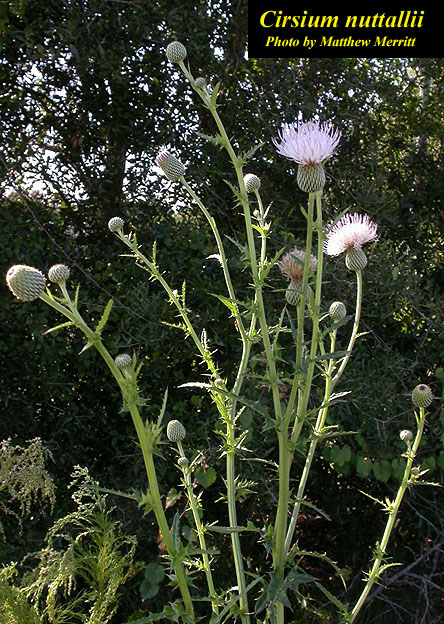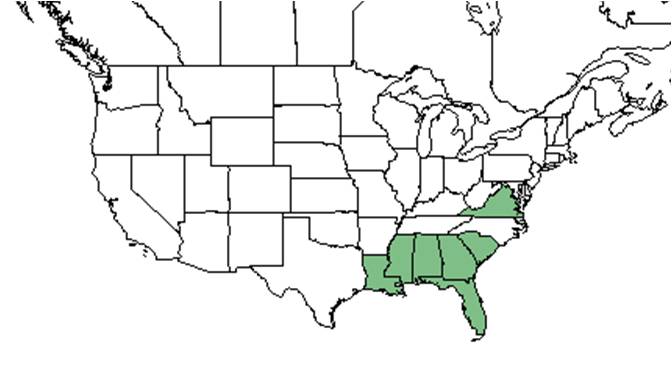Difference between revisions of "Cirsium nuttallii"
Juliec4335 (talk | contribs) |
|||
| Line 34: | Line 34: | ||
In the Coastal Plain in Florida and Georgia, ''C. nuttallii'' can be found in loamy sand of pine savannas, ''Hymenachne'' depressions, and freshwater marsh banks. It will grow in sunny, open and disturbed habitats such as roadsides, railroad tracks, pastures, levees, highways, and upland fallow fields.<ref name="Native">[[http://hawthornhillwildflowers.blogspot.com/2014/06/nuttalls-thistle-cirsium-nuttallii.html Native Florida Wildflowers]]Accessed:December 7, 2015</ref><ref name="FSU">Florida State University Robert K. Godfrey Herbarium database. URL: [http://herbarium.bio.fsu.edu http://herbarium.bio.fsu.edu]. Last accessed: October 2015. Collectors: Loran C. Anderson, James R. Birkhaulter, D. Burch, Emily Earp, R.K. Godfrey, R. Komarek, Marc Minno, Paul L. Redfearn Jr., Cecil R. Slaughter, L.B. Trott, D.B. Ward. States and Counties: Florida: Brevard, Escambia, Gadsden, Jefferson, Lee, Leon, Palm Beach, Polk, Putnam, Taylor, Wakulla. Georgia: Grady. Compiled by Tall Timbers Research Station and Land Conservancy. | In the Coastal Plain in Florida and Georgia, ''C. nuttallii'' can be found in loamy sand of pine savannas, ''Hymenachne'' depressions, and freshwater marsh banks. It will grow in sunny, open and disturbed habitats such as roadsides, railroad tracks, pastures, levees, highways, and upland fallow fields.<ref name="Native">[[http://hawthornhillwildflowers.blogspot.com/2014/06/nuttalls-thistle-cirsium-nuttallii.html Native Florida Wildflowers]]Accessed:December 7, 2015</ref><ref name="FSU">Florida State University Robert K. Godfrey Herbarium database. URL: [http://herbarium.bio.fsu.edu http://herbarium.bio.fsu.edu]. Last accessed: October 2015. Collectors: Loran C. Anderson, James R. Birkhaulter, D. Burch, Emily Earp, R.K. Godfrey, R. Komarek, Marc Minno, Paul L. Redfearn Jr., Cecil R. Slaughter, L.B. Trott, D.B. Ward. States and Counties: Florida: Brevard, Escambia, Gadsden, Jefferson, Lee, Leon, Palm Beach, Polk, Putnam, Taylor, Wakulla. Georgia: Grady. Compiled by Tall Timbers Research Station and Land Conservancy. | ||
</ref> Soils include loamy sand and sandy loam.<ref name="FSU"></ref> | </ref> Soils include loamy sand and sandy loam.<ref name="FSU"></ref> | ||
| + | |||
| + | ''Cirsium nuttallii'' is an indicator species for the Calcareous Savannas community type as described in Carr et al. (2010).<ref>Carr, S.C., K.M. Robertson, and R.K. Peet. 2010. A vegetation classification of fire-dependent pinelands of Florida. Castanea 75:153-189.</ref> | ||
===Phenology===<!--Timing off flowering, fruiting, seed dispersal, and environmental triggers. Cite PanFlora website if appropriate: http://www.gilnelson.com/PanFlora/ --> | ===Phenology===<!--Timing off flowering, fruiting, seed dispersal, and environmental triggers. Cite PanFlora website if appropriate: http://www.gilnelson.com/PanFlora/ --> | ||
Revision as of 22:53, 23 July 2020
| Cirsium nuttallii | |
|---|---|

| |
| Photo by Matthew Merritt, Atlas of Florida Vascular Plants | |
| Scientific classification | |
| Kingdom: | Plantae |
| Division: | Magnoliophyta - Flowering plants |
| Class: | Magnoliopsida - Dicotyledons |
| Order: | Asterales |
| Family: | Asteraceae ⁄ Compositae |
| Genus: | Cirsium |
| Species: | C. nuttallii |
| Binomial name | |
| Cirsium nuttallii DC. | |

| |
| Natural range of Cirsium nuttallii from USDA NRCS Plants Database. | |
Common names: Nuttall's thistle; coastal tall thistle
Contents
Taxonomic notes
Synonyms: Carduus nuttallii (A.P. de Candolle) Pollard
Varieties: none
Description
A description of Cirsium nuttallii is provided in The Flora of North America.
C. nuttallii is a biennial species that develops a deep taproot and basal rosette the first year, then shoots up a single, erect, glabrous stem.[1][2] It can be distinguished from other Cirsium by having branched and many-headed stems.[3]
Distribution
Ecology
Habitat
In the Coastal Plain in Florida and Georgia, C. nuttallii can be found in loamy sand of pine savannas, Hymenachne depressions, and freshwater marsh banks. It will grow in sunny, open and disturbed habitats such as roadsides, railroad tracks, pastures, levees, highways, and upland fallow fields.[1][4] Soils include loamy sand and sandy loam.[4]
Cirsium nuttallii is an indicator species for the Calcareous Savannas community type as described in Carr et al. (2010).[5]
Phenology
Cirsium nuttallii has been observed flowering April through July with peak inflorescence in June and with white to pink flowers.[1][6]
Seed bank and germination
It produces a large number of seeds and has been observed to self-sow freely.[1][7]
Pollination
The following Hymenoptera families and species were observed visiting flowers of Cirsium nuttallii at Archbold Biological Station:[8]
Apidae: Apis mellifera, Bombus griseocollis
Halictidae: Halictus poeyi
Megachilidae: Lithurgus gibbosus
Use by animals
The seeds are eaten by birds, but avoids herbivory from deer.[9] It is the larval host to the little metalmark butterfly.[10]
Conservation and management
Global Conservation Status: G5.[11]
Cultivation and restoration
Photo Gallery
References and notes
- ↑ 1.0 1.1 1.2 1.3 [Native Florida Wildflowers]Accessed:December 7, 2015
- ↑ [Encyclopedia of Life] Accessed: December 7, 2015
- ↑ Krings, Alexander, Randy Westbrooks, and Janine Lloyd. “CIRSIUM NUTTALLII (ASTERACEAE: CYNAREAE) NEW TO NORTH CAROLINA AND AN ILLUSTRATED KEY TO SOUTHEASTERN CONGENERS”. SIDA, Contributions to Botany 20.2 (2002): 845–848.
- ↑ 4.0 4.1 Florida State University Robert K. Godfrey Herbarium database. URL: http://herbarium.bio.fsu.edu. Last accessed: October 2015. Collectors: Loran C. Anderson, James R. Birkhaulter, D. Burch, Emily Earp, R.K. Godfrey, R. Komarek, Marc Minno, Paul L. Redfearn Jr., Cecil R. Slaughter, L.B. Trott, D.B. Ward. States and Counties: Florida: Brevard, Escambia, Gadsden, Jefferson, Lee, Leon, Palm Beach, Polk, Putnam, Taylor, Wakulla. Georgia: Grady. Compiled by Tall Timbers Research Station and Land Conservancy.
- ↑ Carr, S.C., K.M. Robertson, and R.K. Peet. 2010. A vegetation classification of fire-dependent pinelands of Florida. Castanea 75:153-189.
- ↑ Nelson, G. PanFlora: Plant data for the eastern United States with emphasis on the Southeastern Coastal Plains, Florida, and the Florida Panhandle. www.gilnelson.com/PanFlora/ Accessed: 7 DEC 2016
- ↑ [Dave's Garden]Accessed: December 7, 2015
- ↑ Deyrup, M.A. and N.D. 2015. Database of observations of Hymenoptera visitations to flowers of plants on Archbold Biological Station, Florida, USA.
- ↑ [Naturescapes of Beaufort, SC]Accessed: December 7, 2015
- ↑ [What Florida Native Plant is Blooming Today]Accessed: December 7, 2015
- ↑ [NatureServe]Accessed: December 7, 2015